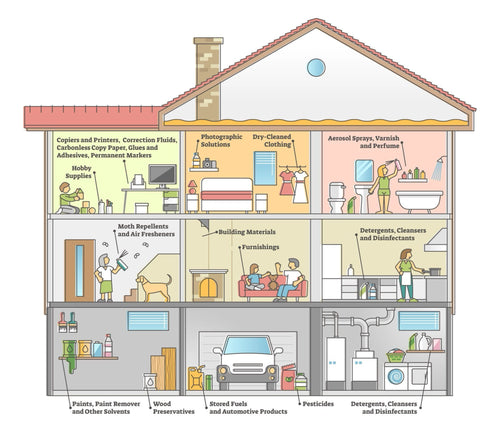
Healthier Indoor Air
The quality of the air we breathe, diseases, and the environment can affect the health of our lungs and cause respiratory problems as well as endanger our well-being.
Indoor vs. Outdoor Air
Air pollution has become a growing health concern for humans and the environment, and while most of us likely think air pollution is a greater concern while outdoors. The EPA (United States Environmental Protection Agency) has found that indoor air is on average 2-5 times (or in some cases up to 100 times) more polluted than outdoor air. By some estimates indoor air pollution inside a typical home is responsible for as much as 50% of all illnesses, which is unsurprising given that we spend up to 90% of our time indoors and continuously breathe indoor air. In fact, the U.S. Environmental Protection Agency (EPA) considers indoor air pollution the number one environmental health problem in the United States.
Dust & Microbes
For every 100 square meters of living space, your home acquires about 12 kg of dust per year. Dust is the primary “vessel” for mites, bacteria, viruses, and germs to enter your lungs.
VOCs (Volatile Organic Compounds)
A large group of chemicals found in many products used in building and finishing materials, like plywood, wood floors, carpets, and paint. VOCs are also present in everyday products like furniture, clothing, toys, cosmetics, household cleaners, tobacco and marijuana products. As these products “off gas”, the harmful VOC gases linger indoors and impact our health through the quality of the air we breathe.
Off-gassing
Off-gassing occurs as items with organic chemicals release gases and particulate matter, known as VOCs (volatile organic compounds). This process pollutes indoor air through building and finishing materials, cleaners, and cosmetics. Most homes rely solely on HVAC systems to filter and circulate the air, which is why Shikkui Paint is often used to complement and reduce wear and tear on HVAC systems.
Sealed Air
Modern, well-insulated homes are praised for energy efficiency, yet one side effect is less air exchange with the outdoors. This results in pollutants building to dangerous levels rapidly due to VOCs within the home.
Health Effects of VOC exposure

VOC (Volatile Organic Compounds)
Harmful gases emitted by a wide range of chemicals and solid objects produced with those chemicals, like when cooking, smoking, and from building and finishing materials as well as common household products.
Common examples of VOCs in daily life include: formaldehyde, benzene, ethylene glycol, methylene chloride, tetrachloroethylene, toluene, xylene,and 1,3-butadiene.
The risk of health effects from inhaling VOCs depends on:
- How much is in the air.
- How long and how often someone is exposed.

Long-Term Risks and Vulnerable Populations
Breathing low levels of VOCs for extended periods may increase the risk of health problems. Studies suggest exposure to VOCs can worsen symptoms for people with asthma or chemical sensitivities, that can result in sick-house syndrome. These exposures differ from occupational exposures in intensity and duration.
It’s important to note that VOCs are a group of chemicals, with each having its own toxicity and potential health effects.
Poor air quality affects everyone, but children are more susceptible to particle pollution due to their higher minute ventilation (breathing intensity) and higher levels of physical activity.

Common Symptoms of Exposure to High Levels of VOCs Include:
Acute/short term exposure (hours to days):
- Eyes, nose & throat irritation
- Headaches
- Nausea/vomiting
- Dizziness
- Worsening of asthma symptoms
Chronic exposures (years to lifetime):
- Cancer
- Liver & kidney damage
- Central nervous system damage
Keeping Your Indoor Air Healthy

Disinfecting the Air
Given all the products and materials that off-gas VOCs in our indoor environments—combined with the presence of bacteria, viruses, mold, dust, and other toxins lingering in the air—one of the most important solutions for maintaining cleaner indoor air is to disinfect the air.
While most HVAC systems filter and circulate air, they cannot fully disinfect it, resulting in poor indoor air quality continuously circulating back into homes and buildings.
Shikkui’s porous surface, with its 12pH, is highly effective at helping neutralize a wide range of pathogens such as bacteria, viruses, mold, VOCs, and odors, as proven by third-party testing under ISO, JIS, and ASTM standards. When these pathogens and toxins come into contact with Shikkui-coated walls, they become trapped and neutralized, leading to cleaner and healthier indoor air. This process reduces the strain on HVAC systems, improving the air that circulates through them.

Regulate Humidity
Humidity is a key factor in indoor air quality, with both high and low humidity contributing to health issues.
High Humidity:
Causes condensation and mold growth, which can lead to the spread of viruses and bacteria, and increase the off-gassing of VOCs. Symptoms of high humidity include fatigue, skin rashes, throat irritation, and worsening of respiratory conditions like asthma and allergies.
Low Humidity:
Extends the lifetime of some viruses on surfaces and increases the risk of airborne transmission. Symptoms include dry skin, itchy throat, dry eyes, and increased vulnerability to airborne viruses and respiratory infections like asthma, bronchitis, and sinusitis. Low humidity can also dry out the mucous membranes that protect the respiratory system.

Air Flow & Filtration
Investing in good air filtration and adequate ventilation supports healthier indoor air. While air filtration systems can reduce dust and particulates, they can also increase energy costs.
This is why a multi-faceted approach is essential for creating healthier air. Solely relying on HVAC and filtration systems leads to increased energy consumption and wear and tear on these systems.
In combination with Shikkui, HVAC systems and air filters can perform more efficiently. Shikkui reduces the number of VOCs, bacteria, viruses, mold, dust, and toxins that pass through HVAC systems and air filters, resulting in cleaner, healthier air recirculated back into your home.